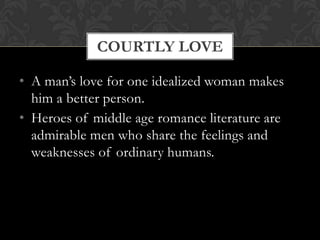Courtly love
- 1. COURTLY LOVE Lisa Keyes and Morgan Gordon
- 2. COURTLY LOVE • A man’s love for one idealized woman makes him a better person. • Heroes of middle age romance literature are admirable men who share the feelings and weaknesses of ordinary humans.
- 3. COURTLY LOVE • Combined with the Code of Chivalry • There were strict rules • Practiced by the members of the king’s courts • Allowed knights and ladies to show their admiration regardless of their marital state • It was a common for a married lady to give a token to a knight of her choice to be worn during a Medieval tournament
- 4. THE ORIGINS OF COURTLY LOVE • Were believed to be in Aquitaine in France in the 12th century and spread to other European countries. • A successful marriage was perceived as one that brought material advantages to the participants and their families.
- 5. THE RULES OF COURTLY LOVE • The following rules and elements of Courtly Love during the Middle Ages were written by the 12th Century Frenchman, Andreas Capellanus: • Marriage is no real excuse for not loving; He who is not jealous, cannot love; No one can be bound by a double love ;It is well known that love is always increasing or decreasing; That which a lover takes against the will of his
- 6. COURTLY LOVE POEMS AND SONGS • The ideals of courtly love was publicized in the poems, ballads, writings and literary works of various authors of the Middle Ages. • Geoffrey Chaucer, the most famous author of the Middle Ages, wrote stories about courtly love in his book Canterbury Tales. • The Miller's Tale describes the art of courtly love
- 7. IMPLICATIONS OF COURTLY LOVE • What practical effect did the convention of courtly love have on the situation of women in the Middle Ages? Very little, if we are to believe social historians, who point out that there is no evidence to show that the legal and economic position of women was materially enhanced in any way that can be attributed to the influence of fin' amors • it provided Europe with a refined and elevated language with which to describe the phenomenology of love.
- 8. WEBSITES. • http://academic.brooklyn.cuny.edu/englis h/melani/cs6/love.html • http://www.middle-ages.org.uk/courtly- love.htm







